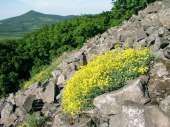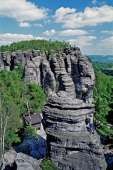Geology
Similarly to most of the territory of the Czech Republic, the whole north-western Bohemia belongs to the Bohemian massif. Its geological structure is very complicated, displaying rocks of diverse age, origin and characteristics, reflected in a rich variety of forms of relief. The area displays the Ore Mountains’ crystalline rocks (gneiss, Telnice granite massif), chalk sediments (particularly sandstone rocks) rise in the Tisá Sandstone Rocks as  well as in erosion remains on the crystalline plateau in the basins of the River Elbe and the River Bílina. Tertiary activity, the most visible in this area, is represented by sedimentary and volcanic rocks. Sedimentary rocks in the area of the Chabařovice Basin (brown coal, overlying gravels, diatonics, sands and clays) are the most important for the economy. Brown coal was also mined underground in the past from volcanic rocks. Coal strata spontaneously combusted many times and burned through, resulting in overlying clays being burnt and converted into hard multicoloured baked clays (around Trmice and Klíše, a neighbourhood in Ústí nad Labem). Volcanic rocks are most frequent in the southern part of the Ústí nad Labem region, situated almost in the very centre of the Bohemian Uplands. Their distinctive relief comprises ridges and peaks originating during Tertiary volcanic activity. However, the present appearance of the countryside occurred later, particularly in the Quaternary era, in which massive efflorescence and erosion formed soft chalk sedimentary rocks. Recent surveys have shown that a large number of medium-height hills originated from the protrusion of volcano vent filling. Today, they are significant landscape dominants. Of geological rocks, basalt is most frequently found here, followed by phonolite, tephrite and trachyte varied by
well as in erosion remains on the crystalline plateau in the basins of the River Elbe and the River Bílina. Tertiary activity, the most visible in this area, is represented by sedimentary and volcanic rocks. Sedimentary rocks in the area of the Chabařovice Basin (brown coal, overlying gravels, diatonics, sands and clays) are the most important for the economy. Brown coal was also mined underground in the past from volcanic rocks. Coal strata spontaneously combusted many times and burned through, resulting in overlying clays being burnt and converted into hard multicoloured baked clays (around Trmice and Klíše, a neighbourhood in Ústí nad Labem). Volcanic rocks are most frequent in the southern part of the Ústí nad Labem region, situated almost in the very centre of the Bohemian Uplands. Their distinctive relief comprises ridges and peaks originating during Tertiary volcanic activity. However, the present appearance of the countryside occurred later, particularly in the Quaternary era, in which massive efflorescence and erosion formed soft chalk sedimentary rocks. Recent surveys have shown that a large number of medium-height hills originated from the protrusion of volcano vent filling. Today, they are significant landscape dominants. Of geological rocks, basalt is most frequently found here, followed by phonolite, tephrite and trachyte varied by  magmatic action differentiating them into really rare types (lead splinters, i.e. camptonite, monchiquite, bostonite and gauteite). The most famous deposit sought after by mineralogists is the trachyte found in the Mariánská Rock, which rises almost in the very centre of Ústí nad Labem denuded by erosion (minerals are found in rock cavities). Basalts are remarkable for their parting columns, displayed in many places of the Ústí nad Labem region. The Quaternary are mostly represented by aeolian loess loams, in the southern part of the Ústí nad Labem region also genuine calciferous loess, slope sedimentary rocks of mixed character at the foothills of the Ore Mountains and volcanic hills of the Bohemian Uplands and river sediments in the basins of the River Elbe and River Bílina. Here we can most frequently find Quaternary fossils represented, for example, by mammoth remains, horns and antlers of large herbivorous animals and skeletal remains of other mammals. The picturesque canyon of the River Elbe with a number of terraces and bends also originated in the Quaternary. The present hilly countryside, which immediately enchants all visitors visiting the Ústí nad Labem region, is a result of the erosion of less resistant rocks.
magmatic action differentiating them into really rare types (lead splinters, i.e. camptonite, monchiquite, bostonite and gauteite). The most famous deposit sought after by mineralogists is the trachyte found in the Mariánská Rock, which rises almost in the very centre of Ústí nad Labem denuded by erosion (minerals are found in rock cavities). Basalts are remarkable for their parting columns, displayed in many places of the Ústí nad Labem region. The Quaternary are mostly represented by aeolian loess loams, in the southern part of the Ústí nad Labem region also genuine calciferous loess, slope sedimentary rocks of mixed character at the foothills of the Ore Mountains and volcanic hills of the Bohemian Uplands and river sediments in the basins of the River Elbe and River Bílina. Here we can most frequently find Quaternary fossils represented, for example, by mammoth remains, horns and antlers of large herbivorous animals and skeletal remains of other mammals. The picturesque canyon of the River Elbe with a number of terraces and bends also originated in the Quaternary. The present hilly countryside, which immediately enchants all visitors visiting the Ústí nad Labem region, is a result of the erosion of less resistant rocks.

